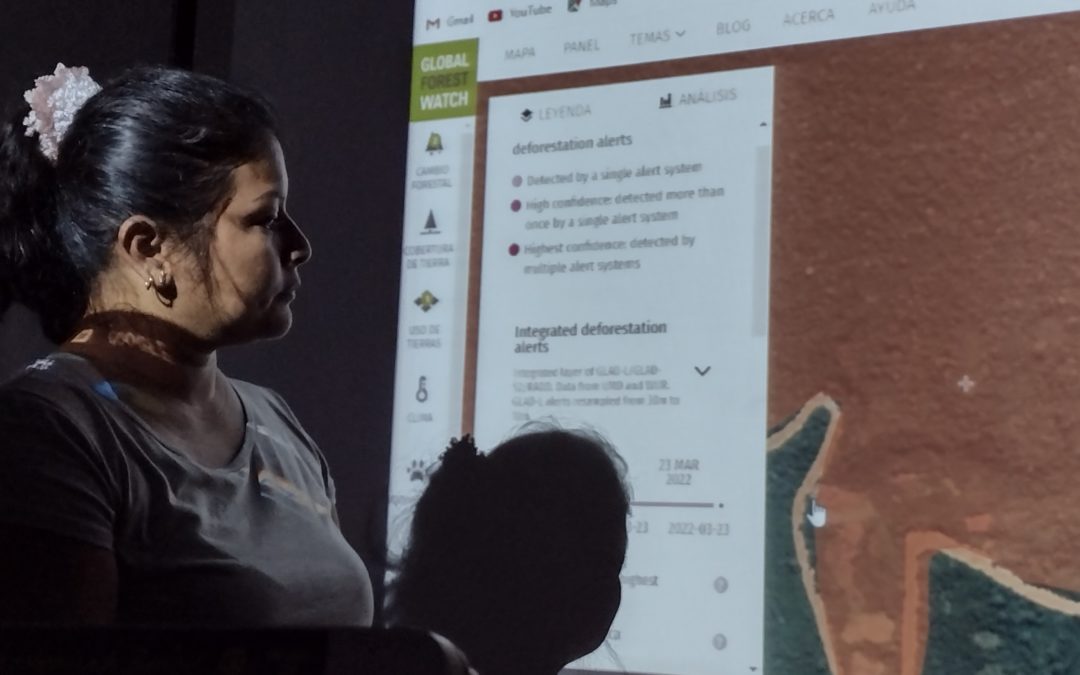Erika and Paola, FENAMAD’s Forestry Monitors, strengthen the monitoring of their communities with geospatial data
During the month of April, the SERVIR-Amazonia Program, with the support of Amazon Conservation (ACCA), a Program partner in Peru, organized a training workshop on Geographic Information Systems and Remote Sensing to monitor threats, aimed at forest monitors, in Puerto Maldonado, Madre de Dios.
Erika and Paola are two indigenous women from the Peruvian Amazon, who use geospatial knowledge to defend their communal territory.
Erika Pacaya Dancurt
The Boca de Pariamanu native community is located in the province of Tambopata, in the department of Madre de Dios, on the banks of the Las Piedras River. The community, which has 4,000 hectares, is located two hours from the city of Puerto Maldonado, an hour, and a half by car, and half an hour by boat. Around 40 families live there and many are descendants of the Amahuaca indigenous people, whose main livelihood is harvesting Brazil nuts, as well as agro-ecological crops, and tourism activities. However, they are also vigilant against the constant threat of loggers and illegal mining.
A few months ago, the President of the Native Federation of the Madre de Dios River and Tributaries (FENAMAD), Julio Cusurichi, visited Boca de Pariamanu and encouraged women to take on more responsibilities in the community, as only men were community directors and forest watchers. “If what is needed is to walk the trails to spot any intruder or trespasser, why can’t I do it? I have the same rights as men,” said Ericka Pacaya Dancurt, mother of two daughters and the only woman who is a member of her community’s forest watch team.
As her youngest daughter has grown up, she has decided to become a forestry monitor to ensure that illegal loggers and miners do not encroach on her territory. Happily at home, her partner recognizes and supports her work.
Erika had some computer skills since she studied technical secretarial work in Puerto Maldonado. These skills helped her to become a forest monitor, which led her to coordinate with GEOBOSQUES, the Ministry of Environment’s platform for monitoring changes in forest cover.
“I dedicate myself to monitoring because I like to know the territory of my community, I like to walk in through the forest. I’m often faster than the four other members of the monitoring team, and I’m more responsible because I arrive early to the meetings. I always beat them,” says Erika, who only joined the Boca Pariamanu Forest Watch this year.
Thanks to the training in Geographic Information Systems and Remote Sensing used for threat monitoring (promoted by the SERVIR-Amazon Program with the support of FENAMAD), Erika has been able to improve her knowledge of geospatial systems and fulfil her vocation to serve her community. “What I like most about the training is that they teach us to control our territories, gathering data with GPS, and that makes it easier for us to make a good report, just by using the internet and our cell phones. It is easier and faster”.
Erika must be alert and act quickly because she knows that illegal mining lurks on the borders of her community and is responsible for water contamination caused by the use of mercury.
Paola Gabriela Quispe
The community of Tres Islas is located in the province of Tambopata, in the sub-basin of the Madre de Dios River, where the Shipibo and Ese’Eja indigenous peoples settled at the beginning of the 20th century. Today there are more than 100 families living in Tres Islas.
As in Boca Pariamanu, illegal logging and mining are the most damaging activities in Tres Islas, affecting the population with a high level of mercury contamination. However, the organized community remains united in denouncing and complaining about any threat. Paola Gabriela Quispe, a young veterinary student who joined the forest watch a few months ago, lives there.
“As a forestry monitor, I go out into the forest two or three times a month with my partner. I have received training on the use of drones and how to locate illegal timber,” says Paola.
This is not the first time that women have been promoted as members of the forest watch in Tres Islas. About 5 years ago, 4 women belonged to the group of 10 monitors, but little by little they withdrew. An incident with one monitor that put her health at risk, discouraged the community from including them on a permanent basis. However, they continue to participate in the community board. They are older women, so they plan to encourage more young women to become leaders.
Part of their struggle is to vigorously and steadfastly confront illegal loggers and miners that permanently enter their territory. Tres Islas is also known because in 2003 it appointed the first female President of a native community in Madre de Dios. This was Juana Payaba Cachique, and it was an inspiring event for many women in the community, including Paola. Part of her challenge is to generate the support of her family to care for the house, and thus have time to carry out her work and create confidence in the community.
Paola has received several training courses on drones and how to cube wood, for example. However, she considers this course with FENAMAD and SERVIR-Amazon as more comprehensive, as it has given her an introduction to Geospatial Information Systems and Remote Sensing (GIS), vector data and Raster data, as well as data collection in the field, and how to project it on a map, among other topics.
Erika and Paola stood out on the course for their interest and commitment in learning how to use the different systems and learning about Peru’s official resources as well.
Marina Irigoyen A.
Gender Advisor, SERVIR-Amazon Program
April 2022



